Latest News
November 2, 2007
By Douglas Clark
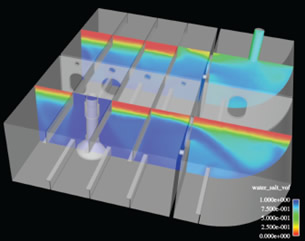 Contours of volume fraction of saltwater in two planes of 1/3-scale model tank facility after one tank volume is exchanged.This image shows the effect of the incoming flow rate on the impinging jet flow through one of the manholes into the side hopper tank, which is the curved tank compartment to the right side of the figure.Red represents pure freshwater, which is the initial resident fluid and bluerepresents pure saltwater, which is the incoming fluid. |
Biological stowaways threaten environment
The unintentional transport of non-indigenous species stems from the age-old sailing technique of using ballast to stabilize a vessel and prevent capsizing. Today, this practice of taking extra weight onboard usually amounts to nothing more than water held in tanks at the bottom of a cargo ship’s hull. When a typical cargo ship takes on goods at port, it releases ballast water to compensate for the additional weight of the new cargo. When it unloads cargo somewhere else, it pumps in new ballast water.
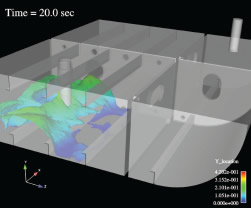 Isosurface of saltwater volume colored by vertical position 20 seconds into the 1/3-scale model simulation. | 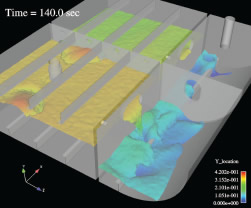 This is the same simulation as the one to the left, with isosurfaces of saltwatervolume colored by vertical position 140 seconds into the simulation. |
This intake and release of water is where problems arise, because the water taken on as ballast contains various forms of ocean life ranging from tiny plankton to larger species such as fish, snails, jellyfish, and other plants and animals. When this sea life is introduced into a new marine environment and a particular species finds itself suddenly free of natural predators in its new surroundings, it can thrive — to the detriment of other plants and animals — and can quickly tip the delicate balance of the local ecosystem. In addition to environmental mayhem, related economic consequences often follow as well, such as the decimation of the local fishing industry.
To the credit of U.S. government officials, this phenomenon has not gone unnoticed, and regulations require or recommend — depending on the U.S. port — a procedure known as “ballast water exchange,” which aims to reduce, if not eliminate, the introduction of non-indigenous species at ports.
The procedure consists of flushing ballast water tanks in mid-ocean, following the logic that species living in coastal ports are not likely to survive in mid-ocean environments. While at sea, the ship’s crew pumps water into the tanks until they reach capacity and overflow onto the deck. This is done until a quantity of water equaling three times the tanks’ maximum volume has been pumped through. The assumption is that this will flush the tank of 95 percent of any coastal water it was carrying. Ships also have the option of modifying the procedure, so long as it exchanges 95 percent of the tank’s water for mid-ocean water.
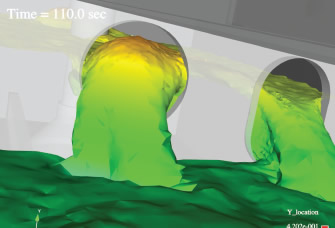 Zoomed view from tank interior of volume fraction isosurface that is colored by vertical position. |
Are well-meant standards really effective?
The catch is — despite the good intentions of our current government regulations — no one really knows whether the ballast water exchange procedure consistently reaches its own standard of 95 percent exchange. The standard is based on broad assumptions about tank design, and its efficacy has been questioned.
Wilson’s research, which is funded by the U.S. Department of Commerce’s National Oceanic and Atmospheric Administration (NOAA), seeks to shed light on this issue, noting that since computations to date raise concerns about the ability of the ballast exchange procedure to meet the 95 percent replacement requirement for all ship types, improvement is needed. Currently, notes Wilson, even when the ballast water exchange procedures are carried out to the letter of the law, “it’s possible some ship types, as they exist, just aren’t going to meet the 95 percent requirement.”
In search of the answer, Wilson has applied CFD to examine exactly what goes on during the water-exchange procedures. In addition to determining how well the procedure works, he also has his sights on potential ways to improve it. “Another way of potentially using the CFD methods we’re using,” Wilson remarks, “is to look at how you might modify the tanks or change the procedure itself in some way.”
One of the issues that make the ballast water exchange procedure so complex are variations in ballast tank construction. Economy of space is one of the keys to ship design, and that means that ballast tanks must conform to the many space and size constraints of each specific ship. The underpinnings of a ship’s structure affect its design, and the enormous tanks require their own support structures and must provide for maintenance access. As a result, tanks are composed of numerous chambers, bulkheads, access openings, and other geometric irregularities that make for a complex flow pattern.
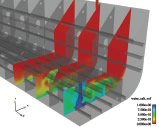 Contours of saltwater volume fraction on cut-planes through several compartments of a full-scale ballast water tank including structuraldetails and inlet bellmouth. |
Visualizations puttanks to the test
In the first phase of testing, then, Wilson and his colleagues used a one-third-scale model of four typical ballast tank compartments to conduct preliminary CFD analysis and refined their CFD methods to make sure they were able to produce accurate results. Once satisfied with the accuracy, they moved on to the next phase to produce flow predictions for full-scale tanks.
The researchers used FLUENT, a general-purpose commercial CFD solution recently acquired byANSYS, Inc., and created visualizations of the results by feeding the data into EnSight, a software program from Computational Engineering International (CEI).
“For these types of predictions,” Wilson points out, “we have a fully transient, time-dependent process. EnSight has been our tool of choice for looking at these transient data sets because it has a lot of good features to animate what’s going on. It gives us the flexibility to make surfaces transparent, turn them off, change perspective, and animate the solution — all at the same time. It’s a lot more informative to look at what’s going on in the tank if we can do all those things on the fly, rather than look at a static view of the data.”
Using EnSight visualizations, the researchers are able to easily identify slow-moving pockets of water and dead spots where water fails to circulate sufficiently, despite efforts to flush the tank. These dead spots are exactly where sediment and various plants and creatures can potentially collect, only to be discharged later on, once a vessel is in port.
Unfortunately for the environment, the full-scale prediction Wilson and his colleagues carried out did not meet the required 95 percent replacement of ballast water after three volume exchanges due to the structural features in typical ballast tanks. The good news, however, is that the researchers have formed some theories about how the specific type of tanks they were studying could be modified for greater water-exchange efficiency.
Wilson and his colleagues are seeking to further study the subject, hoping to extend research to new areas. They would like to investigate different types of tanks to find ways to make ballast water exchange procedures work more efficiently, and to identify areas where tank design can be improved for that purpose.
Non-indigenous Invaders from the Deep Learn more about the sea lamprey in the Great Lakes. Take a look at the many ways, including ballast water exchange, in which more than 160 documented non-indigenous plants and animals have entered the Great Lakes. The invasion of non-indigenous species is a serious problem reaching far beyond marine ecology. Something as seemingly harmless as bringing tropical fruit back from an island vacation can wreak havoc if the wrong insect hitches a ride on your mangoes. Peruse a list of the top 100 worst invasive species from around the globe, or type in your state or country for a look at the non-indigenous species in your area. Learn more about the research going on at the U.S. Navy’s the Carderock research facility. |
More Information:
ANSYS, Inc.
Canonsburg, PA
ansys.com
EnSight
Computational Engineering Intl. (CEI)
Apex, NC
ensight.com
Douglas Clark is a freelance PR and marketing writer who specializes in science and technology. He is based in New York. Send e-mail about this article to DE-Editorsmailto:[email protected].
Subscribe to our FREE magazine, FREE email newsletters or both!
Latest News
About the Author
DE’s editors contribute news and new product announcements to Digital Engineering.
Press releases may be sent to them via [email protected].






